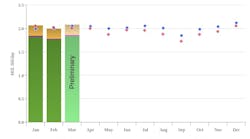Guntis Moritis
Production Editor
DENVER, Sept. 23 -- The estimated vast unconventional resources hold much promise for substantially adding to the world's energy needs, but developing these resources entails overcoming many restraints, attendees were told Sept. 22 during the opening session of the Society of Petroleum Engineers Annual Conference & Exhibition in Denver.
The speakers expected production from these resources to grow but each listed some practical barriers and limitations that may hinder development such as the rising infrastructure costs and limited human capabilities.
Demand forecasts are that the world will need 50% more energy in the next 25 years, creating a need to continue developing unconventional resources from tight gas, shale gas, coalbed methane, Canadian oil sands, and oil shale, as discussed the session.
Oil price
Marshall Adkins, director of energy research and managing director, equity research, Raymond James & Associates, emphasized the need to have sufficiently high oil prices to develop unconventional resources economically.
"At today's prices development of these resources makes sense," he said.
Recent high oil prices have squeezed oil demand out of system but in the future demand will continue increasing because of energy needs in such countries as China and India, Adkins said.
He does see oil demand continuing to fall in the economically developed countries. In the US, he expects a continued minus 2% year-on-year demand drop.
Adkins noted that the world does not have an oil bubble because of the limited potential to increase production rates, especially in non-Opec countries. He added that more rigs are drilling but production growth is not taking place.
He expects an average $130/bbl oil price in 2009.
Tight gas
Charles B. Stanley, executive vice-president and chief operating officer, Questar Corp., noted that tight gas development entails much more intense investment and activity than conventional gas
Stanley said conventional gas reservoirs had a 70-80% recovery factors with a few wells and limited infrastructure. In contrast unconventional gas development requires a large number of wells, he said. The wells decline by 60-70% during the first year and recover about one-half of their recoverable gas in 5-6 years, with the remaining gas produced in the next 6-40 years, he added.
In the US, about one-half of its produced gas is from tight gas, shales, and coalbeds, and by 2020 this will increase to 60-70%, according to Stanley.
He noted, currently the US has 8% year-to-year ramp up in unconventional gas production.
Innovations in drilling, completions, and reservoir characterization have allowed development of these resources, Stanley said. Some innovations he noted were in rig design, bit design, new drilling fluids, directional drilling, fracing, coring, and microseismic.
Stanley said permitting problems persist because of the local, state, US agencies are not staffed to handle the large number of wells being needed to recover gas from unconventional resources.
Oil shale
Glen Vawter, executive director, National Oil Shale Association, said current research and development in oil shale primarily concerns in situ retorting. In the 1980's before the oil shale industry went bust in the US, the projects involved primarily mining and surface retorting.
He noted that four of the main companies doing work are in the oil shales in Colorado are Royal Dutch Shell PLC, ExxonMobil Corp., Chevron Corp., and American Shale Oil Co. in Colorado.
Vawter noted that this work is still in the research, development, demonstration phase, but he also expects gradual US oil shale development with possible production rates of 100,000-200,000 b/d in the next 25 years.
He also noted that oil shales have much potential in many parts of the world.
Contact Guntis Moritis at [email protected].
